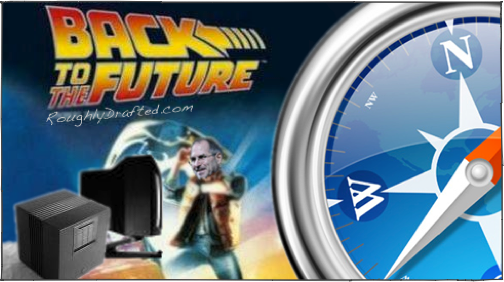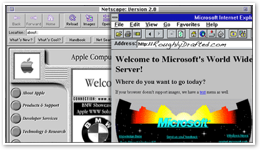


Imagine jumping back in time to 1993 and rescuing the world from fifteen years of enslavement to proprietary technologies that held up innovation and put development decisions in the hands of a few salesmen.
Imagine having the opportunity to convince the world that:
-
•The coming web browser wars between Netscape and Internet Explorer were completely unnecessary.
-
•That the PC desktop needn’t be tied to one vendor with limited vision and little regard for its partners.
-
•That 1993’s state of the art in object technology didn’t have to be buried to in order to kowtow to Microsoft.
-
•That software could be delivered better, cheaper, faster and with greater security without Bill Gates.
Of course even with time travel that would be difficult to pull off; various individuals and companies back then did try in vain to convince the tech world that things were headed in the wrong direction, and that open engineering, using open source and open standards, would advance the state of the art in technology more effectively. 

Advocates of an Open World.
Among these visionaries were Richard Stallman, who had advocated free software since the early 80s. He started the Free Software Foundation, the GNU project, and defined the GNU General Public License for “free as in speech” software projects.
In the late 80s, Steve Jobs’ NeXT built its operating system on open source code from BSD and learned first hand that reinventing the wheel was not necessary. In the mid 90s, NeXT opened its own core technologies as the OpenStep specification, which was implemented by GNU as GNUStep.
NeXT worked for years to compete against the Cairo vaporware Microsoft promised to deliver but didn’t. Following Apple’s acquisition of NeXT, Jobs pursued an increasingly open development path for Apple, and has advocated the use of common and open industry standards in actual practice, not just in theory or for show.
After the arrival of NeXT, Linus Torvalds began work on the free Linux kernel, in part because BSD was held up in legal issues due to proprietary code lawsuits. Torvald’s kernel was used by GNU to deliver Linux as part of a complete operating system.
In the late 90s, Eric Steven Raymond and Bruce Perens further helped to refine the concept of open development and direct public attention to its benefits with the Open Source Initiative. It was the OSI that helped to promote the transformation of Netscape into the open source Mozilla project.
Those involved in standards-based, open source development do not always agree. Torvalds and Stallman, and Stallman and Raymond are key examples of high profile disputes about how open software should work. Many open source advocates are also critical of companies like Apple that operate on both sides of the open source line.
Enemies of an Open World.
Outside of the open world however, there is plenty of agreement. Because the principles of open development force an open playing field, companies with implementations that can’t compete in an open market are enemies of open development ideals.
Open development is a particular threat to Microsoft. Its executives, including Bill Gates, Steve Ballmer, and many underneath them, commonly refer to open source as a “cancer” plaguing the software industry. Microsoft’s success is based not on merit, but on market control leveraged through closed, proprietary development.
A number of analysts have made it their lives’ work to advocate a closed world dominated by a single player with no competitive pressure to innovate.
Rob Enderle started at the Giga Information Group, which was bought out by Forrester Research, and then went to Dataquest, which was acquired by Gartner. Every one of those think tanks was programed to deliver anti-open rhetoric. Enderle himself now works alone to deliver lazy journalists with anti-open, pro-Microsoft sound bites.
Many pro-Microsoft advocates are confused by the simple concepts of open development, and attempt to throw around words such as open and proprietary without any understanding of what they mean. They commonly misrepresent Microsoft as being the source of an open standard, because developers can write Windows apps!
An Open Web Without Time Travel?
Without any means of time travel, nothing can be done to salvage the 90s. We can however, change the future. Armed with a decade and a half of hindsight, we now know without any controversy that domination of the industry by one party does not result in rapid advancement and innovation.
This is true whether the industry dominator is Apple or Microsoft. Apple’s reign over the graphical desktop under John Sculley failed to effectively advance the state of the art from 1988-1995, just as Microsoft’s reign has failed since 1995. The desktop needs vibrant competition.
However, the opportunity for competition presented in the mid 90s by the web was purposely stifled by Microsoft. It thwarted the potential for web based applications by tying web development into its monopoly position with Windows. Instead of a competitive platform, the web was made merely another extension of Windows.
The Return of an Open Web.
After being reborn inside Mozilla, Firefox emerged as an effort to build a standards based browser. Opera, KDE’s Konquerer and Apple’s Safari similarly worked to establish a common, open web platform based on published standards for interoperability.
Since Microsoft still maintains a majority share of the web browser installed base, why not simply establish Internet Explorer as the standard? Some seem to think that Microsoft’s standards are like the QWERTY keyboard, and while not perfectly ideal, are at least good enough and so widely used that they are a de facto standard.
The problem is that IE does not follow standard behaviors at all. Imagine if every new batch of keyboards shipped with keys in different places, and that certain keys only worked correctly in Word, and that third party keyboards could not type vowels when used on a Windows PC. That’s the real problem with settling on non-standards!
WHATWG’s HTML 5, FTW.
In 2004, Apple, Mozilla, and Opera began working together on WHATWG, the Web Hypertext Application Technology Working Group, in order to improve web standards by codifying behavior more clearly with the goal of making web applications easier to build, more robust, and more consistent across platforms.
While WHATWG members invited Microsoft to chair the group, it declined to participate. Since the group is open, anyone can actually contribute to it. WHATWG is now working together with the W3C to finalize HTML 5 as next generation web language.
HTML 5 defines far more details on how things should work, so individual companies aren’t left to invent their own ways to do basic tasks. By defining a common and standard way to do foundational things, companies can innovate by providing the best implementation, rather than delivering products that aren’t compatible.
Until HTML 5 There’s Web 2.0.
Until HTML 5 is released, the closest thing to an open web platform is today’s Web 2.0, which is just a buzzword for the concept of using the open standards that now exist to power a new generation of open web apps.
Beyond the fanciful pastel colors and rounded edges associated with it, Web 2.0 is really about web apps are intended to work with any browser that supports the currently defined standards. This levels the playing field, which is good for innovators, but bad for companies hoping to maintain the status quo of the 90s.
An open web provides plenty of room for innovative competition between browser developer s, and affords consumers the most choice. How will the opening of the web affect Apple, Microsoft, and Mozilla?
s, and affords consumers the most choice. How will the opening of the web affect Apple, Microsoft, and Mozilla?
 s, and affords consumers the most choice. How will the opening of the web affect Apple, Microsoft, and Mozilla?
s, and affords consumers the most choice. How will the opening of the web affect Apple, Microsoft, and Mozilla?The Positioning of Safari, Firefox, and Internet Explorer.
While Mozilla COO John Lilly fretted about the imagined threat of Apple displacing Firefox in market share, the only entity that should be sweating bullets with the introduction of Safari for Windows is Microsoft; it certainly has the most to lose.
Microsoft’s retention of web browser market share is based upon three increasingly difficult to maintain factors:
-
•Easy: lazy customers who can't be bothered to download an alternative.
-
•Tricky: customers who depend on custom development that is entangled with dependancies on IE or Windows.
-
•Hard: customers who prefer IE for its features and ongoing innovation.
Microsoft passively relies upon the first factor to maintain its monopoly position. The second factor requires actively working to maintain barriers to defection. The third factor requires the most investment from Microsoft with the least payback. Since IE is free, it makes no sense to innovate unless competitive forces demand it.
Relative to Microsoft, Mozilla is in the opposite position with Firefox:
-
•Hard: it has to actively market the merits of downloading its alternative.
-
•Hard: it has to offer seamless interoperability to retain that interest.
-
•Hard: it has to maintain constant innovation to stay ahead of IE.
Apple's positioning with Safari on Windows is identical to Mozilla’s, although it enjoys a default position on the Mac platform similar to Microsoft’s. That puts Apple in the middle, similar to the position Apple occupies in desktop operating systems between Linux and Windows.
That allies Apple with Mozilla, as all the work invested in marketing the idea of alternative downloads, promoting interoperability, and driving innovation benefits both efforts while undermining Microsoft’s interests in maintaining the status quo of a web entangled with Windows and a specific browser.
Learning from the Past.
Has the rest of the tech world learned much from the last decade and a half of web browser history? Today a variety of vendors are pushing development of “rich Internet applications,” all of which seek to tie web development to their own technologies, just like Internet Explorer and the old Netscape:
-
•Adobe’s Apollo/AIR, based on Flash and Flex (I like to call it Flashplications).
-
•Microsoft’s Silverlight, based on .NET and Vista’s WPF and XAML.

-
•Sun’s JavaFX, based on new extensions to Java.
-
•Mozilla’s XUL, the basis of the old Mozilla Application Suite.
It’s not impossible to learn from the past though. Over the last decade, Apple has shifted its online development approach away from similar attempts to stuff interactive web development into its own QuickTime architecture, to a policy of using open industry standards.
Scouring Scum off the Web with Ajax.
Apple’s web development policy has centered on the ECMA's standard JavaScript and the standardized asynchronous HTTP request architecture for XML. Together, these open technologies are referred to as Ajax.
Apple has partnered with Google to promote Ajax web development, and is working to expand its own use of standards-based development.
Apple's own corporate website has moved away from using proprietary plugins like Flash to instead implement pioneering levels of interactivity exclusively in Ajax.
One example is the search results field on the new Apple.com website, which presents immediate hits as the user types, and presents them in categorized results after the query is finished.
Apple’s new query field not only searches for web page results, but also actually searches the iTunes Store as well, including movie trailers and podcasts. Ask Apple.com about RoughlyDrafted, and you’ll now get my podcast in the search results!

There Is One More Thing...
There is yet another reason for bringing Safari to Windows, which I'll present in the next article. Guess what it is!
Like reading RoughlyDrafted? Share articles with your friends, link from your blog, and subscribe to my podcast!
Did I miss any details?

Haloscan Q107
 Bookmark on Del.icio.us |
Bookmark on Del.icio.us |  Discuss on Reddit |
Discuss on Reddit |
 Critically review on NewsTrust
Critically review on NewsTrust
 Forward to Friends |
Forward to Friends | 
 Get RSS Feed |
Get RSS Feed |
 Download RSS Widget
Download RSS Widget
Check out the Daily Show Multi-Pass on iTunes.com

Next Articles:
Does Leopard Look Like Vista?
BHOze and the BHOzing BHOzers that BHOze Them.
EA’s Intel Mac Games: WINE and Cheese?
This Series
The Future of the Web: Safari, Firefox and Internet Explorer
Saturday, June 23, 2007

Ad













